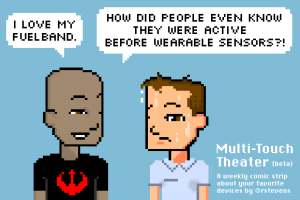It seems we’re all into health tracking these days.
It started with weight and calories, moved on to steps and miles and then to sleep (or in most cases, lack of sleep). Now it’s turned to heart rate, blood sugar, cholesterol, oxygen saturation and NikeFuel.
The Quantified Self
In Apple’s Health app for iPhone, for example, there are 67 (and counting) settings to collect data — from electrodermal activity to forced expiratory volume to inhaler usage to numbers of times fallen to peripheral perfusion index to your consumption of all kinds of vitamins.
There are some 100 apps (and counting) that integrate with Apple’s mobile health data aggregator. And dozens of devices and gadgets (and counting) that help you track your health — from bands to watches to straps to scales to pulse oximeters and now even clothing.
This exchange from the online cartoon Multitouch Theater by Rich Stevens pretty much sums up where we stand with health-tracking wearable tech.
The cartoon got me thinking: There’s collecting data. Then there’s collecting meaningful data. And then there’s actually doing something with those data.
I have been tracking calories for almost four years. It has allowed me to lose 70 pounds, keep it off and jettison any and all medications.
It has also made me hungry for more data.
I run with a Nike+ GPS watch to track mileage, distance and pace. I use a Jawbone UP24 to wirelessly track my steps and sleep. I have a Kinsa “smart” thermometer that works with my iPhone to track my temperature.
Data Everywhere, but Going Nowhere?
I have lots of data. But it all stays with me.
While those data have helped me make meaningful and healthy changes in my own life, the future is clearly in having those data integrate with my “real” medical record. That means sharing it with my doctor and perhaps even my health insurance company.
Those days are coming. Just last week, at the mHealth Summit in Maryland, top physicians from Duke University and New Orleans-based Oschner Health System talked about how they are integrating patient-generated data into their patients’ medical records. Duke and Oschner, along with others like Mayo Clinic and Stanford University, are part of a pilot with Apple to transfer these data into medical records, in this case through Epic.
Opportunities Knock
Physicians are excited to have these data — it’s an opportunity to see what’s really happening with their patients outside of the exam room. It is information that can help facilitate dialogue that could lead to healthier lifestyles and behaviors. And there are amazing opportunities for clinical trials.
But it is the patient engagement part that must be carefully cultivated. Data, in isolation, can be overwhelming and confusing. It must be accompanied by context, education and action, all of which requires input and engagement from those with clinical expertise.
Many people will receive gifts of health-related tech this holiday season — and they will eagerly jump in to the wild world of the quantified self. We need a commitment from patients and caregivers to help each other figure out what to do with all these data — and make it meaningful for everyone.






5 Comments
Hey there! This is my first comment here so I just wanted to give a quick shout out and
say I genuinely enjoy reading your blog posts. Can you suggest any other blogs/websites/forums that deal with the same subjects?
Thanks for your time!
Thank you. We have a Blog Roll on the site which spotlights blogs we respect and follow.
Hi there, I would like to subscribe for this webb site to get hottest updates, thus where can i do it please help out.
If you go to the top right hand corner of the webpage and click on “Get the Digest,” you’ll be able to subscribe to our weekly alerts.
Hello, Thanks for sharing such a nice blog with fantastic information.best blog….